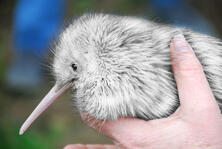 Meet the little white chick we call Lucky #13: a rare kiwi bird who hatched last month in New Zealand and has captured the world’s imagination. Locals (and locums) are flocking to see the cuddly oddity – the 13th of 14 new chicks hatched at Puhaka Mount Bruce, a conservation center near Wellington.
Meet the little white chick we call Lucky #13: a rare kiwi bird who hatched last month in New Zealand and has captured the world’s imagination. Locals (and locums) are flocking to see the cuddly oddity – the 13th of 14 new chicks hatched at Puhaka Mount Bruce, a conservation center near Wellington.
Named Manukura by Māori Elders, the moniker means ‘of chiefly status’ and the fuzzy creature is considered a rare good omen. Why? His/her fair feathers, of course. Although 14 chicks hatched
(in what has been the most successful breeding season in the history of the wildlife center), Manukura was the ultimate surprise: all-white, when brown was the color of the day for the rest of the brood. And the first white kiwi to be hatched in captivity.
The fuzzy creature (whose sex won’t be determined for another few weeks) isn’t an albino, either, but a rare offspring of the brown kiwi transferred to Pukaha from Little Barrier Island last year as part of a plan to increase the kiwi gene pool and grow the population long-term. "The kiwi population on Little Barrier Island has birds with white markings and some white kiwi, but this was still a big surprise,” said Pukaha chairman Bob Francis.
Pukaha board member and Rangitane chief executive, Jason Kerehi, said Māori tribal elders saw the white chick as a ‘tohu’ or ‘sign’ of new beginnings. “Every now and then something extraordinary comes along to remind you of how special life is. While we’re celebrating all 14 kiwi hatched this year, Manukura is a very special gift.”
Very special indeed. Compared to the period between 2005 and 2010 - when only
10 chicks were hatched at Pukaha - this season had been a major success. Says Francis, "Faster breeding is exactly what was intended by the transfer, but were blown away by the number of chicks produced so quickly."
That’s exceptional news for this beloved national symbol of New Zealand, which is endangered. In fact, this
70-million-year-old flightless bird’s numbers have decreased nearly 86% over the past 36 years due to predators and loss of habitat. You can help save kiwi birds here.
While white Manukura may be destined for a life in advocacy – having already attracted global attention for his species – this nocturnal little scrapper has also contributed hugely to the wildlife center, where visitor numbers have been considerably higher since Manukura hatched. His/her daily 2:00 feedings are among the favorite events of the day.
Reports that the white chick would be at greater risk from predators has also been a concern, though Manukura made the move to an enclosure in the outdoors yesterday, having reached the expected milestones: a required weight of one kilogram (2.2 pounds) and eating on his own. The kiwi is the only bird in the world known to have nostrils at the end of its bill, which is put to good use sniffing out food like insects and berries, though “encouragement feeding” by a handler at the center goes on for up to 10 days with the chicks. Watch it here.
Two of this season’s chicks have already been released into the Pukaha forest. Kia ora, flightless feathered friends! Watch Manukura shake her tail feathers here, or head over to YouTube. You won’t be disappointed.
Have a Manukura sighting or story? Share it now.
Manukura - the little white kiwi. from Mike Heydon on Vimeo.



 Back
Back